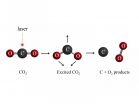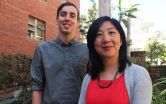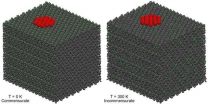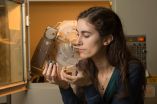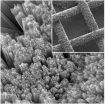(Press-News.org) Johnny Depp has an unforgettable face. Tony Angelotti, his stunt double in "Pirates of the Caribbean," does not. So why is it that when they're swashbuckling on screen, audiences worldwide see them both as the same person? Scientists from the University of California, Berkeley, have cracked that mystery.
Researchers have pinpointed the brain mechanism by which we latch on to a particular face even when it changes. While it may seem as though our brain is tricking us into morphing, say, an actor with his stunt double, this "perceptual pull" is actually a survival mechanism, giving us a sense of stability, familiarity and continuity in what would otherwise be a visually chaotic world, researchers point out.
"If we didn't have this bias of seeing a face as the same from one moment to the next, our perception of people would be very confusing. For example, a friend or relative would look like a completely different person with each turn of the head or change in light and shade," said Alina Liberman, a doctoral student in neuroscience at UC Berkeley and lead author of the study published Thursday, Oct. 2 in the online edition of the journal, Current Biology.
In searching for an exact match to a "target" face on a computer screen, study participants consistently identified a face that was not the target face, but a composite of the faces they had seen over the past few seconds. Moreover, participants judged the match to be more similar to the target face than it really was. The results help explain how humans process visual information from moment to moment to stabilize their environment.
"Our visual system loses sensitivity to stunt doubles in movies, but that's a small price to pay for perceiving our spouse's identity as stable," said David Whitney, associate professor of psychology at UC Berkeley and senior author of the study.
Previous research in Whitney's lab established the existence of a "Continuity Field" in which we visually meld similar objects seen within a 15-second time frame. For example, that study helped explain why we miss movie-mistake jump cuts, such as Harry Potter's T-shirt abruptly changing from a crewneck into a henley shirt in the "Order of the Phoenix."
This latest study builds on that by testing how a Continuity Field applies to our observation and recognition of faces, arguably one of the most important human social and perceptual functions, researchers said.
"Without the extraordinary ability to recognize faces, many social functions would be lost.Imagine picking up your child at school and not being able to recognize which kid is yours," Whitney said. "Fortunately, this type of face blindness is rare. What is common, however, are changes in viewpoint, noise, blur, and lighting changes that could cause faces to appear very different from moment to moment. Our results suggest that the visual system is biased against such wavering perception in favor of continuity."
To test this phenomenon, study participants viewed dozens of faces that varied in similarity. Each six seconds, a "target face" flashed on the computer screen for less than a second, followed by a series of faces that morphed with each click of an arrow key from one to the next. Participants clicked through the faces until they found the one that most closely matched the "target face." Time and again, the face they picked was a combination of the two most recently seen target faces.
"Regardless of whether study participants cycled through many faces until they found a match or quickly named which face they saw, perception of a face was always pulled towards face identities they saw within the last 10 seconds," Liberman said. "Importantly, if the faces that participants recently saw all looked very distinct, the visual system did not merge these identities together, indicating that this perceptual pull does depend on the similarity of recently seen faces."
In a follow up experiment, the faces were viewed from different angles instead of frontal views to ensure that study participants were not latching on to a particular feature, say, bushy eyebrows or a distinct shadow across a cheekbone, but actually recognizing the entire visage.
"Sequential faces that are somewhat similar will display a much more striking family resemblance than is actually present, simply because of this Continuity Field for faces," Liberman said.
INFORMATION:
yphoon Phanfone's eye appeared the size of a pinhole on visible imagery from NASA's Aqua satellite on Oct.3.
The MODIS instrument or Moderate Resolution Imaging Spectroradiometer that flies aboard NASA's Aqua satellite captured a visible image of Phanfone moving through the Northwestern Pacific Ocean on Oct. 3 at 4:20 UTC (12:20 a.m. EDT). The tiny open eye of the storm was surrounded by a thick band of thunderstorms. The MODIS image also showed a very thick and large band of thunderstorms south of the center and spiraling into the eye.
On Thursday, Oct. 2, Typhoon ...
VIDEO:
Mexico's western coast is again dealing with rain, wind and rough surf from another tropical storm. NOAA's GOES-West satellite saw the formation of Tropical Storm Simon on Oct. 2. A...
Click here for more information.
Mexico's western coast is again dealing with rain, wind and rough surf from another tropical storm. NOAA's GOES-West satellite saw the formation of Tropical Storm Simon on Oct. 2. A NASA animation of NOAA's GOES-West satellite imagery shows the development ...
About one-fifth of the Earth's atmosphere is oxygen, pumped out by green plants as a result of photosynthesis and used by most living things on the planet to keep our metabolisms running. But before the first photosynthesizing organisms appeared about 2.4 billion years ago, the atmosphere likely contained mostly carbon dioxide, as is the case today on Mars and Venus.
Over the past 40 years, researchers have thought that there must have been a small amount of oxygen in the early atmosphere. Where did this abiotic ("non-life") oxygen come from? Oxygen reacts quite aggressively ...
Curiosity helps us learn about a topic, and being in a curious state also helps the brain memorize unrelated information, according to researchers at the UC Davis Center for Neuroscience. Work published Oct. 2 in the journal Neuron provides insight into how piquing our curiosity changes our brains, and could help scientists find ways to enhance overall learning and memory in both healthy individuals and those with neurological conditions.
"Our findings potentially have far-reaching implications for the public because they reveal insights into how a form of intrinsic motivation ...
White Americans may view diversity and multiculturalism more negatively as the U.S. moves toward becoming a minority-majority nation, UCLA psychologists report.
As part of their study, the researchers divided 98 white Americans from all regions of the country — half male, half female, with an average age of 37 — randomly into two groups. One group was told that whites will no longer be the majority in the U.S. by 2050; in fact, this is likely to be true as soon as 2043, according to some projections. The second group was told that whites would retain their majority status ...
BELLINGHAM, Washington, USA -- New applications of structures and materials that replicate complex yet efficient arrangements that have evolved in nature over millennia are featured in a special section on biomimetic and bioinspired materials for applications in biophotonics in the October issue of the Journal of Biomedical Optics. The journal is published by SPIE, the international society for optics and photonics, in the SPIE Digital Library. Several of the peer-reviewed articles are accessible via open access.
"Biomimetic and bioinspired materials present an emerging ...
VIDEO:
The video compares the two sliding states of the C60 flake attached to the tip of the microscope: a) commensurate state at low temperature where the C60 do not rotate...
Click here for more information.
About 3500 years ago, man invented the wheel to make life easier. Then, thanks to Leonardo Da Vinci's genius, the wheel was made smaller to obtain ball bearings. And today? "Today we are trying to get even smaller: scientists are thinking about nano-bearings", comments ...
PULLMAN, Wash.—A Washington State University undergraduate has helped develop a new method for detecting water on Mars. Her findings appear in Nature Communications, one of the most influential general science journals.
Kellie Wall, 21, of Port Orchard, Wash., looked for evidence that water influenced crystal formation in basalt, the dark volcanic rock that covers most of eastern Washington and Oregon. She then compared this with volcanic rock observations made by the rover Curiosity on Mars' Gale Crater.
"This is really cool because it could potentially be useful for ...
COLUMBUS, Ohio—Is it a solar cell? Or a rechargeable battery?
Actually, the patent-pending device invented at The Ohio State University is both: the world's first solar battery.
In the October 3, 2014 issue of the journal Nature Communications, the researchers report that they've succeeded in combining a battery and a solar cell into one hybrid device.
Key to the innovation is a mesh solar panel, which allows air to enter the battery, and a special process for transferring electrons between the solar panel and the battery electrode. Inside the device, light and oxygen ...
Too many stroke patients in Canada are not getting the rehabilitation they need to return to a healthy, active life, according to a new study which will be presented at the Canadian Stroke Congress in Vancouver tomorrow. The research findings strongly suggest that such decisions are being made based on what services are available in the health system rather than what patients really need.
It found that overall just 16 per cent of patients with stroke were discharged to inpatient rehabilitation but that the rates varied widely by province (1% to 26%) and hospital (0% to ...


